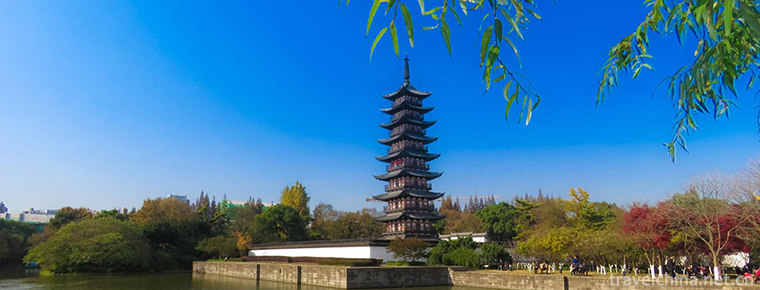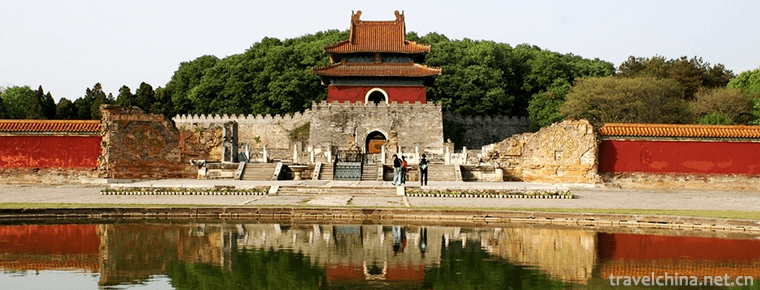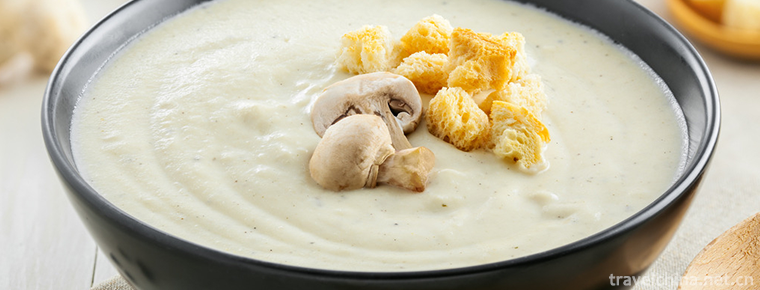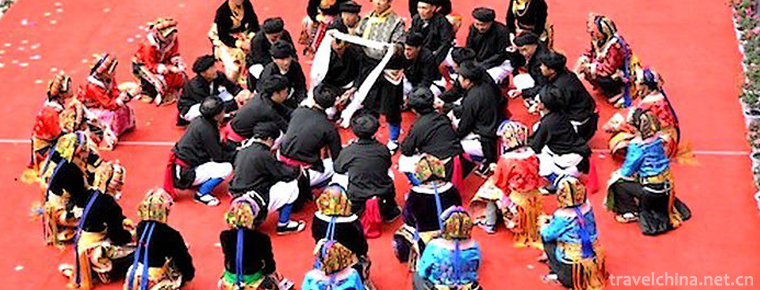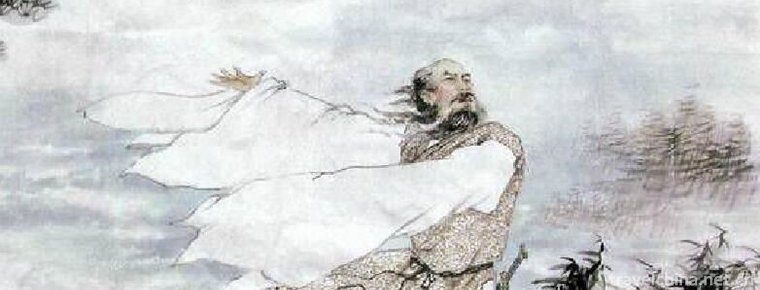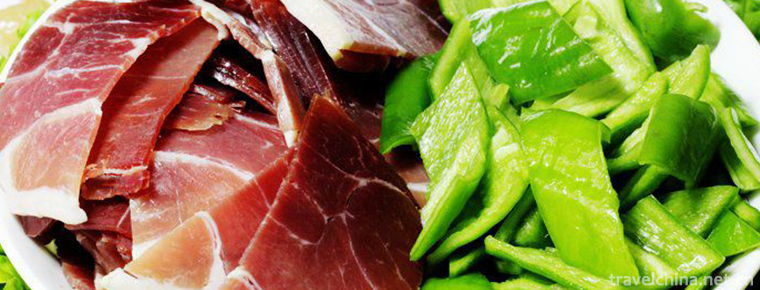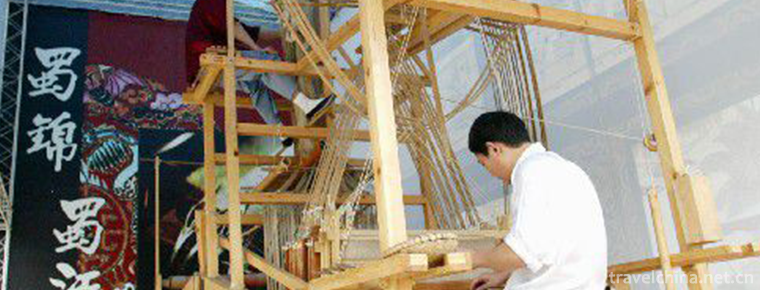Bai people circle three spirits
Bai people circle three spirits
Bai people around Sanling, a traditional festival in Dali Bai Autonomous Prefecture, Yunnan Province, is one of the national intangible cultural heritage.
Bai people around Sanling is a grand traditional festival of Bai people in Lili, and it is also a kind of Bai people's popular song and dance full of life flavor. The Bai people's three spirits around originated in Nanzhao Period of Tang Dynasty, and Yang Qiong, a Bai scholar in Qing Dynasty, also recorded in The Trivial Records of Central Yunnan. Around Sanling, the Bai people's self-entertainment meeting to greet the gods in the leisure season is popular in Bai villages around Erhai Lake, Cangshan, Dali Bai Autonomous Prefecture, Yunnan Province. It is a grand gathering of Bai people's spring singing and dancing in the busy farming season.
On May 20, 2006, the Bai people's ring Sanling was approved by the State Council to be included in the first batch of national intangible cultural heritage list, project number_-41.
historical origin
"Dali Bai people around the three spirits" is a traditional folk cultural activity formed by the Bai people in their long-term farming life and rice cultivation customs, which takes entertaining gods and people as its content, singing, dancing and worship activities as its carrier, and contains many cultural contents such as history, religion, folklore, art, trade and so on. "Around the three spirits" is also written as "around the mountain forest", "around the mulberry forest", "around the mountain forest" and so on. Bai language is called "Guan Shang Lan" (or written as "Jiao Shang Na"). Its original meaning may refer to three public houses in ancient times. The so-called "three spirits" refer to the three God symbols on the west coast of the Meihai Sea. They are the important "principal" in Bai nationality's unique worship of "principal" and the Buddhist gods introduced into Dali area. The Temple characters worshiped by them are respectively called "Buddha Capital" (Dali Chongsheng Temple), "Shendu" (Dali Qing Dongben Master Temple) and "Xiandu" (Erhe Shentong). As the "three spirits around" is a traditional folk custom activity, which has not been paid attention to by the official and the upper class in history, there are few relevant historical documents. Tang Fanchuo's "Yunnan Zhi Manyi Customs" and Yang Qiong, a Bai scholar in the Qing Dynasty, described the "three spirits around Yunnan" at that time.
Cultural characteristics
From various perspectives, there are many national and cultural characteristics in the three spirits:
(1) Agricultural Culture
According to archaeological and ancient documents, as early as 3000 years ago, the inhabitants of Haimen site in Jianchuan had mastered the technology of rice planting. By the Tang Nanzhao period, agricultural production had been developed in that period. According to the Nanzhao Dehua Stele, it is said that "the plateau is a paddy field, and the plateau is a paddy field, and the paddy pond should be cleared, and the gardening industry of Xiashu trees should be carried out." This shows that the agricultural cultivation culture in Dali Bai nationality area has a long history. In terms of investigating and studying the primitive attributes of the Bai people's sprouting around the three spirits, this cultural phenomenon highlights the prayer and worship for the reproductive power of the farming of rainwater, sunshine and land. In the long-term production activities, people realized the close relationship between rain and sunshine in spring and summer for rice production. They thought that devotion to gods and entertainment of gods could bring convenience to agricultural production. Therefore, various activities around the three spirits had typical and strong characteristics of agricultural culture.
(2) Worship of God
Benzhu is the abbreviation of "benevolent landlord" or "local landlord". The three spirits around is the most representative festival in Bai's native culture. First of all, the main places of activities around the three spirits are mostly the main original temples worshipped by the Bai people in Dali. Secondly, the main gods worshiped and sacrificed in festivals are Jingu Xinuluo, Duan Zongbang and Duan Chicheng. Therefore, on April 25 of each summer calendar, the village owners come to Chao Shendu and "go around three spirits" on famous days. During the festival, men, women, old and young in villages and villages all flock around the three spirits, and the main gods worshiped by villages also go around the three spirits. People and gods enjoy each other. The world of human beings and gods merge in special festivals. Villagers worship the gods with blood and food, sing and dance wildly, pray for the gods to give them good weather, rich grain, and rich religious and cultural colors.
(3) The legacy of the ancient "society"
"She" is a sacrificial unit in ancient China, which was very popular as early as the Spring and Autumn Period. In today's flexible movement around the three, the traces of the "community" are still obvious. This is the "community tree" commonly used in people's singing and dancing. The general supplies are two or three meters high living willow or bamboo branches, hanging gourds, red cloth and other ornaments. A branch represents one or more natural villages, and at the same time represents the principal god of the village. The community tree should be supported by witches or elderly men and women to guide people around the three spirits to the place around the three spirits. Every seventy-one village has its own owner (i.e. the branch represents the owner of each village), each in a line, in its own ranks, and in the Xiaochao dynasty, to offer branches to the people around the three spirits. Before God. The branch here refers to the ancient cultural relics of the "divine tree" which prevailed in Chinese history but has long disappeared in Dali.
Main activities
From April 23 to 25 of the lunar calendar, the Bai people living in hundreds of villages in Erhai area of Cangshan Mountains take sacrificial utensils, simple luggage, food and cooking utensils as units, and spontaneously form a "three spirits" worship team to attend meetings from all sides.
Model composition
Through long-term practice, the "three spirits around" team has formed a fixed pattern, which is generally divided into three parts: the leader is a man and a woman (sometimes two men or two women), two old people holding willow branches and oxtail (called Hua Liu Shu old man); in the middle, in addition to one person playing flute, there are dozens of male and female dancers holding "New King Whip" and "Money Drum"; while in the end, there are dozens of male and female dancers holding "New King Whip Whip" and "Money Drum". A person blowing leaves and dozens of women singing and dancing, holding fans or straw hats formed a "long line of serpents".
Specific processes
First day
Under the leadership of the flower willow old man, he gathered at the early the 23th day of the fourth month of the Chinese lunar calendar in Town God's Temple, Dali to burn incense candles and prepare for the journey. Then the whole team went north along the foothills, first to worship the sacred temple of Buddha, then to worship the principal Temple of Chaoyang village under the Wutai peak of Cangshan Mountain by burning incense, then to worship the principal Temple of "Emperor Fumin", called "Southern Dynasty (worship)", and then to the village of Qingdong, to worship the sacred source Temple of Buddhist temples and the "principal" Temple of Qingdong, known as "Shendu", called "Northern Dynasty (worship)". Then, in and out of the temple venues, play "bully whip" and "money drum", dance fans, sing Bai tune, bury pots around Shendu in the evening to cook, and then sleep in the cave temple and the surrounding wild woods at night.
The second day
On April 24, the procession of sacrificial spirits started from Qingdong and marched to the northeast one after another, bypassing the nine altars gods of Xizhou ancient town. After a short rest in Sifang Street and a couplet of songs, they went all the way out of the ancient town and went east to Erhe Shentong, the "fairy capital" of Hejuanjiang village near Erhai Lake. They worshiped Chicheng Benzhu, the hero of chopping python, who symbolized the God of Erhai Sea. The Dongjing Music Society in the village was in the ancient opera. The "Hole Sutra" was staged on the stage, welcoming the arrival of the "three spirits around" team. In the evening, a meal is built around the Erhai Lake and the temple. In the evening, songs and dances are performed and all-night singing is performed.
On the third day
On April 25, people bought folk cloth, clay sculptures, paper flowers and other small crafts to bring back to their relatives and friends who could not come at home, so that relatives and friends also guaranteed the "luck around the three spirits" and received the protection of the gods. "Around the three spirits" troop started from Hejunjiang village one after another, heading south to Majiuyi village on the northern Erhai Lake of Dali city to worship the security emperor. This day is the main festival of Majiuyi village. Villagers gathered their sedan chairs to the village for the worship of the people around the three spirits, and eventually they separated and returned home.
Logo
Participants in the "three spirits around" have three distinct symbols: one is that the temple is covered with "sun cream" (a kind of sunflower made of colored paper), and the "sun cream" soaked with the essence of wind oil can prevent heatstroke, but also worship the sun; the other is that a red belt is tied on the left arm to express a blessing after worshiping the "Lord"; the third is to wear a straw hat with fresh lace, playing a role. Dress, shade from the sun and rain, and sing in pairs to hide shame.
During the "Three Spirits Round" festival, men and women are allowed to meet or even encouraged to meet, whether men, women, children or old, with their pre-marital lover in these days. Provide couples who cannot be husband and wife with a couple of days of social, family allowance and free from moral responsibility. It's like some elderly people who have participated in the festival sing, "My teeth have fallen off and I can't sing anymore, but I'm coming to sit with you in silence for a while.
Inheritance and protection
Inheritance value
"Three spirits around" is actually a great gathering of Bai folk culture and a great exhibition of various music, singing and dancing arts. It combines almost all kinds of performing arts popular among Bai people in Dali, fully demonstrating the rich and colorful existence and high artistic achievements of Bai folk art in Erhai area.
The Value of Anthropology, Ethnology and Folklore
The "three spirits around" embodies the ancient Bai people's "principal" culture of purple worship and community sacrifice, and carries many important historical and cultural information and primitive memories of the Bai people. The long history of farming and the relatively stable cultural environment in Dali area have preserved a large number of primitive ceremonies for farming sacrifices. By offering sacrifices to the owner in the form of singing and dancing to amuse the gods, it has become an important factor for the preservation and continuation of the Bai cultural tradition. Apart from farming sacrifices and the belief of owner, the three flexible cultural connotations convey the very important reproductive worship information of Bai nationality.
Platform Inheritance Value
"Around the three spirits" is a stable folk cultural activity both in time and space. In the long-term development process, the art of singing and dancing contained in it not only formed its own unique fixed pattern, but also made the skills developed and improved by the activities themselves. Because of its important influence in folk cultural life, it has become an important dance combination for Bai folk singing and dancing artists to exchange and inherit their skills. In daily life, the traditional dance of the Bai nationality has rarely been seen, but the "three spirits around" is shown on an overall scale. Through the activities around the three spirits, the traditional dance and song forms of the Bai nationality in Dali have been completely preserved.
The Technological Value of Dress Dressing
The clothes and dresses of the people around the three spirits are unique, and they are capable of making innovations. Through the aspect of clothing decoration, it fully embodies the Bai people's artistic aesthetic view, superb craft level and creative talent, remembers the formation, development history and reflects the profound cultural connotation of Bai people's clothing.
Inheritance status
Faced with the changes of the times and the impact of powerful culture, the ancient folk cultural activities around Sanling are facing the crisis of gradual disappearance. From 1987 to 2007, with the change of rural industrial structure and the continuous improvement of modern agricultural production level, the lifestyle of Dali Bai people has changed greatly. With the popularization of mass media and the increase of mobility of social members, Bai village culture, which has a long history and cultural tradition, can not be in the dominant position. The values that have maintained and supported Bai traditional life style for a long time are also changing dramatically. The farming culture of Bai traditional society is weakening day by day, and the traditional moral concepts have been greatly impacted. In addition, the development of local tourism and the increasing population of villages and other factors have greatly changed the space environment on which the three flexible movements depend, which has aggravated the decline of the three flexible movements. This ancient Bai folk cultural activity will face the crisis of gradual extinction.
Inheriting characters
Zhao Piding, male, Bai nationality, born in 1942, is a Zuoyi villager in Xizhou Town, Dali Bai Autonomous Prefecture. Dali Bai Autonomous Prefecture of Yunnan Province declared that Zhao Piding was selected as the representative successor of the second batch of national intangible cultural heritage projects.
protective measures
On March 25, 2016, as one of the protection points of Bai nationality's "three spirits around" activity route for the national intangible cultural heritage project, the "Xiandu Erhe Temple" of Heyicheng Natural Village, Jinhe Village Committee, Xizhou Town, was listed and protected by Dali State Bureau of Culture and Sports and the State intangible cultural heritage protection center.
Dali State Bureau of Culture and Sports and Dali Bai Nationality Society organized donations from heritage holders and applied for subsidies from the local government to comprehensively renovate and protect the environment of the main places of activities around Sanling; organized a special survey of the three spirits around, collected and recorded relevant video materials and archives of successors; and the successors represented by Zhao Piding set up in the local community. Training courses and seminars teach the performing skills related to the three spirits; Dali Town, Xizhou Town, Qingdong Village and other communities, schools and other groups regularly spontaneously organize activities to inherit the skills of the three spirits, and encourage young people to learn the traditional culture and performing arts related to the three spirits.
social influence
Important activities
On May 29, 2016, the first "around three spirits" exhibition was held in Qingdong Village, Xizhou Town, Dali City, under the auspices of the State Cultural and Sports Bureau, the State intangible cultural heritage protection center and the government of Xizhou Town, Dali City, and the Dali City intangible cultural heritage protection and Management Institute and the Qingdong Village Committee of Xizhou Town, Dali City.
On April 29, 2018, organized by Yunnan Ethnic Villages Co., Ltd. and the intangible cultural heritage protection center of Dali Bai Autonomous Prefecture, Yunnan Ethnic Villages Bai Ethnic Villages folk custom meeting and Huahai Carnival were held in Yunnan Ethnic Villages with the theme of "singing and dancing around Sanling and Huahai Carnival Ethnic Villages".
Cultural anecdotes
There are many legends about the origin of the three spirits.
First of all, long ago, Dali Daba was a vast ocean. The sea water had been submerged to the hillside of Cangshan Mountain. The ancestors of the Bai nationality lived in the mountains and forests and lived by hunting. Every time they get prey, people sing and dance around the campfire to celebrate victory. Therefore, it is also called "around the mountains and forests".
In the White Kingdom, beside the magnificent palace of the King, there were three dense mulberry forests, and the people were not allowed to enter. One day, Prince Bai was lost in the mulberry forest. The king ordered the people around him to go into the mulberry forest to find Prince Bai. When people enter the mulberry forest, they are singing and dancing to enjoy themselves. So it is also called "around mulberry forest".
Third, in Nanzhao, there was an emperor named Duan Zongbang, who had outstanding skills and loved the people as children, and brought many benefits to the people. People called him "Emperor of the People". On April 23 of the lunar calendar, the emperor took his family and ministers to Wutaifeng to honor him. Unfortunately, he died of a sudden illness. The people mourned him and built the Shengyuan Temple in Wutaifeng. Duan Zongbang was also regarded as the head of the central government and ruled the "500 God Kings". On his anniversary, people carried all kinds of sacrifices to Chongsheng Temple, Shengdu Shengyuan Temple and Xiandu Jingui Temple for three days and three nights to express their condolences. So it's called "around three spirits".

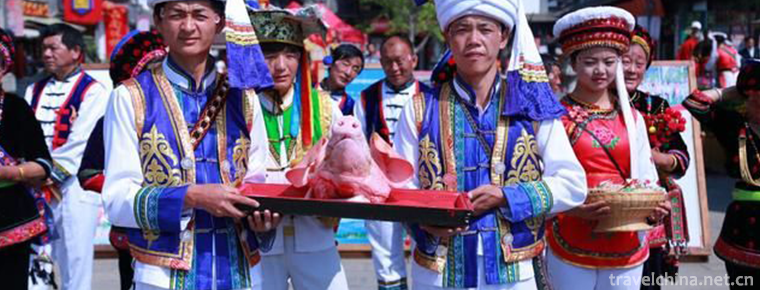
-
Shanghai Fangta Garden
Fangta Garden is one of the gardens in the ancient city of Songjiang, which is mainly composed of historical relics. The garden covers an area of 182 mu. The site was originally the downtown center of.
Views: 134 Time 2018-12-19 -
Bashang grassland
Bashang grassland, also known as the first grassland in the north of Beijing, is located in Hebei Province. It refers to the meadow grassland formed by the steep rise of grassland and the reasons of c.
Views: 115 Time 2019-01-02 -
The Ming Toms
The Obvious Tomb is located on Chunde Mountain, 5 kilometers northeast of Zhongxiang City, Hubei Province. It was built in 1519 in Zhengde, Ming Dynasty. It was built in 1566 in Jiajing.
Views: 142 Time 2019-02-07 -
Narati Scenic Spot
Narati Tourist Scenic Area, located in Xinyuan County, Xinjiang, is located in the hinterland of Tianshan Mountains, the eastern end of the Ili Valley, with a total planning area of 960 square kilomet.
Views: 48 Time 2019-02-07 -
Shui Dong gou
The Shuidonggou scenic spot in Ningxia is the earliest Paleolithic cultural site excavated in China. It is known as the birthplace of Chinese Prehistoric Archaeology.
Views: 144 Time 2019-02-08 -
Pearl rice paste
Pearl rice paste is a delicacy. The main raw material of this dish is fresh pearl rice. The main condiment of this dish is sugar. This dish is mainly made by boiling..
Views: 296 Time 2019-03-23 -
Bo Ba Shen en
Bobassengen is a unique folk large-scale narrative mass pot village dance created by Ganbao Tibetan Village in Jiarong Tibetan area, Lixian County, Sichuan Province. "Boba" .
Views: 389 Time 2019-04-04 -
The Dragon Boat Festival
Dragon Boat Festival, also known as Dragon Boat Festival, Double Boat Festival, Midday Festival, Dragon Boat Festival, Zhengyang Festival, Bath Orchid Festival, Tianzhong Festival,.
Views: 99 Time 2019-04-28 -
Ham making skills
Xuanwei ham production technology is a traditional handicraft in Xuanwei area of Yunnan Province. Xuanwei ham is a famous local traditional specialty..
Views: 161 Time 2019-05-05 -
Ming style Furniture Making Skills
Ming-style furniture production techniques began in the Five Dynasties, after the Song Dynasty, including Liao and Jin Dynasties. In the Ming Dynasty, it reached a brilliant peak and developed into di.
Views: 114 Time 2019-06-05 -
Shu Brocade Weaving Techniques
Shu brocade weaving has a long history. The earliest written records were found in the reign of Huiwen King in the Spring and Autumn Period and Qin Dynasty. During the Warring States Period, Shu Broca.
Views: 110 Time 2019-06-15 -
Biological resources in Dazhou
There are more than 400 species of vertebrates in Dazhou City, including 60 kinds of mammals, 230 kinds of birds, 14 kinds of reptiles, 10 kinds of amphibians and 85 kinds of fish. There are 52 species of national and provincial key protected wild an.
Views: 363 Time 2020-12-20
